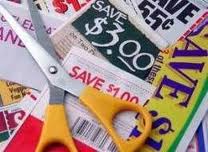What are coupons?
I like to think of a coupon as money. When you hand over that little slip of paper that contains a barcode, you instantly get a discount off your total purchase. Coupons may seem like only $0.50 here or $0.75 there, but they really add up overtime.
Categories of coupons
There are two different categories of coupons – Store Coupons and Manufacturers Coupons. Look at it this way, store coupons are a store promotion given by retailers such as CVS, Target or Walgreens. This discount comes from the store itself and not from the manufacturer of the product.
On the other hand, manufacturers coupons are distributed by the maker of the product. Stores get reimbursed for the manufacturers coupon by the retailer. Stores are reimbursed the face value of the coupon plus a handling fee. Don’t let cashiers bully you into thinking you are “stealing” from the store by using coupons!
Coupons can be deceiving.
Make sure you read the print on a coupon. Many times the manufacturer will show a picture of an expensive product on the coupon. However the wording may say “good on ANY product”.
The print may also specify a size requirement. If there is no size listed, that coupon could be a goldmine. Look for the smallest sized product to use the coupon on if there is no size specification.
What does $1/2 mean?
The coupon will tell you how many items you need to purchase in order to use it. If it says $1 off 2 or $1/2 that means you need to buy two qualifying items to get the $1 off. If it says buy one ____ get one ____ free, you must buy both items.
On many deal or coupon blogs you will see coupons written out similar to this format:
$0.55/1 Hillshire Farm Deli Select Lunchmeat, exp. 2-12 (RP 01/09/11)
What that means is:
There was a $0.55 off one Hillshire Farm Deli Select Lunchmeat coupon that expires 2/12/10 found in the RedPlum insert from the 01/09/11 Sunday newspaper.
Look over the list of other coupon terminology for further common abbreviations and acronyms.
Do Not Double
Many coupons will say “Do Not Double”. However, some stores do not pay attention to that wording. The general rule is if the bar code starts with a “5”, the coupon will double automatically when scanned. If it starts with a “9”, it will not double. Of course this practice will vary by store- some may override the cash register to not allow coupons that say “Do Not Double” to double.
Did you miss the beginning of this series? Make sure you check out where to find coupons!
I would love to answer your couponing questions. Please send me an email or leave a comment!
Latest posts by Renae Chiovaro (see all)
- Last Minute Batgirl Costume - October 22, 2016
- Agnes & Dora: Comfortable & Affordable Clothing - September 19, 2016
- Life is a Highway - September 17, 2016








[…] variety- such as Limeade or Raspberry Lemonade. This is a great example of why it is important to read the print on coupons rather than look at the picture. The Simply Orange Juice is more expensive than their other […]